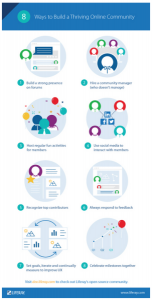The world’s online footprint continues to expand at astonishing rates, leaving us with big shoes to fill when it comes to online customer service. This is especially true in the B2C sector, where, as Twitter recently published, tweets aimed at B2C organizations are growing at 50% per year, with more and more people turning to social media to interact with the brands they use on a regular basis.
The astonishing part is, a massive 40% of those tweets are essentially still being ignored by the companies in question. This problem isn’t unique to Twitter. Consumers are turning to Facebook, LinkedIn, Instagram and others to voice their concerns and questions. Social media customer service is no longer a choice – it’s an essential piece of your customer experience strategy.
The challenge lies in the fact that social media is like a living, breathing entity, with its constantly evolving algorithms and consumer-driven trends. Building a successful social media customer service plan involves a number of considerations, such as the ones we discuss below.
RESPONSIVENESS
One of the toughest questions is whether social media customer service is a responsibility of the marketing team or the contact center team. While the marketing team consists of experts in portraying brand image via these digital tools, contact center agents are on the frontlines of customer interaction and issue resolution. So who should be held accountable? When we built our first social media customer support team for a leader in the online grocery space, effective collaboration between marketing and customer service teams was the single most important ingredient for success. That collaboration allowed us to build a model that enhanced the company’s ability to respond quickly and effectively.
Let’s break it down: one of the reasons many consumers turn to social media is that it is inherently real time interaction. There’s no hold music, automated menus, or post-call surveys. Plus, in times of crisis, social media can offer the only available tool for communication. Ultimately, the internet is at your customers’ fingertips, with social networks offering ultimate responsiveness. And companies need to keep up.
Contact centers are experts in forecasting and scheduling, giving them the 24/7 advantage that a marketing team, typically tied to a 40-hour work week, can’t match. Twitter’s recent report states that 72% of consumers who make a complaint over social media expect a response within an hour. These kind of expectations require flexibility and efficiency, as well as an intimate understanding of process and customer experience. Provide a customer with an effective and efficient resolution via social media, and that’s one less phone call you’ll receive later.
TOOLS & TECHNOLOGY
While social media serves to make a consumer’s life a little easier, it does present an extra element of complexity for organizations responding to these consumers. You may think that the most straightforward strategy in social media customer service would be to keep a diligent eye on your Twitter feed, Facebook notifications, or LinkedIn messages, but this is in fact an extremely narrow view.
On Twitter alone, there are a number of ways a user may reference your brand, be it through a mention, direct message, or just in passing. It’s the last scenario that presents a challenge. For a successful social strategy for customer care, you need some tools in place that will alert you to these indirect mentions that Twitter wouldn’t otherwise bring to your attention. Ensure you have an efficient tagging protocol in place to help you more effectively monitor brand-related activity across all social networks. Tracking and analyzing brand engagement, whether it’s positive, negative or ambivalent, will allow you to uncover trends and issues and make intelligent decisions.
AGENT PROFILING
Building a team for social media customer service requires a carefully profiled team of agents. There’s no question that these individuals need to be tech-savvy with strong writing skills. But there’s more to it.
These individuals are essentially bridging the gap between customer service and the marketing team, which means they need to have a clear understanding of both. It also requires them to be passionate about serving customers and empowered to make a difference via these brief yet powerful interactions. Consistent delivery is key, as they are walking a fine line between personal interaction and efficient issue resolution, all within a very public realm. Ultimately, the best agents for social media customer support are personable and perceptive with strong technical capabilities and excellent judgment for risk mitigation.
BRAND SHOWCASING
Unlike a phone call, social media customer service leaves a clear digital trail, available to current and future customers the moment they run a Google search. With this is mind, it becomes clear that although the contact center team is often the best choice to manage this role, they need to be well versed in your brand’s vision and marketing goals. When you’re deciding to work with an outsourced contact center partner, choose a provider that cares about assimilating their team of agents into your brand and culture.
Any social media interaction adds to a company’s brand image, and these agents need to match the right voice and tone. The challenge of social media is that consumers are often protected by the anonymity of the internet, meaning they are often harsher online than they might be in other situations. Official responses to their complaints and comments need to be solution-oriented, without getting defensive. Building brand loyalty and customer retention through social media requires a delicate balance of personable authenticity and process-focused resolution.
BEST PRACTICES
If your brand is inundated with consumer tweets (recall situations, for example, can spike your volume in mere seconds) or you simply don’t have enough resources to tackle them as responsively as you’d like, Twitter suggests a “triage” strategy. Analyze and prioritize social engagement with a number of considerations in mind: Most importantly, is a comment a direct mention or message to your brand or is it a broad passing comment? It’s best to tackle the direct ones first. Secondly, establish the parameters for prioritization – will your agents be required to assess the influence of the user? We know social media thrives on shareability, and if a user who engages with you has a large, active following, their mentions, direct or indirect, you may want to consider what protocols you will put in place for interacting with high ranking influencers – consider the risks and rewards of those interactions. A public conversation with major influencer can mean your audience reaches a wide audience with one post. That can work to your advantage in high volume situations like a service disruption.
Additionally, make sure agents are well trained in when and how to adeptly and tactfully move conversations from the public realm to private direct messaging. Risk mitigation is key – basically, your agents need to be able to assess sentiment, determine how broad the audience is, and how best to collaborate with the consumer to find a resolution before they can begin the process of resolving the issue.
If an issued is moved from public to private, it can be extremely valuable to close the loop in public so the audience to the conversation understand a resolution has been reached. For example, on Twitter, posting a closing tweet like “Thanks for connecting through DM. Glad we were able to make things right for you!” lets anyone following the original conversation know that you didn’t just drop the ball or ignore the problem.
Another strategy to consider is creating content to answer common questions more effectively. This is where a strong bridge between the contact center team and the marketing team is key. Linking to a blog post, white paper, or how-to article in response to a customer’s problem creates an efficient resolution while also providing valuable information that can serve to increase customer loyalty and even customer conversion.
BRINGING IT ALL TOGETHER
For organizations whose business goals are to increase efficiency, maximize cost-effectiveness, and build customer loyalty, there’s no doubt that increased social media customer service efforts are valuable in achieving these objectives.
Digital & Social Articles on Business 2 Community(5)





